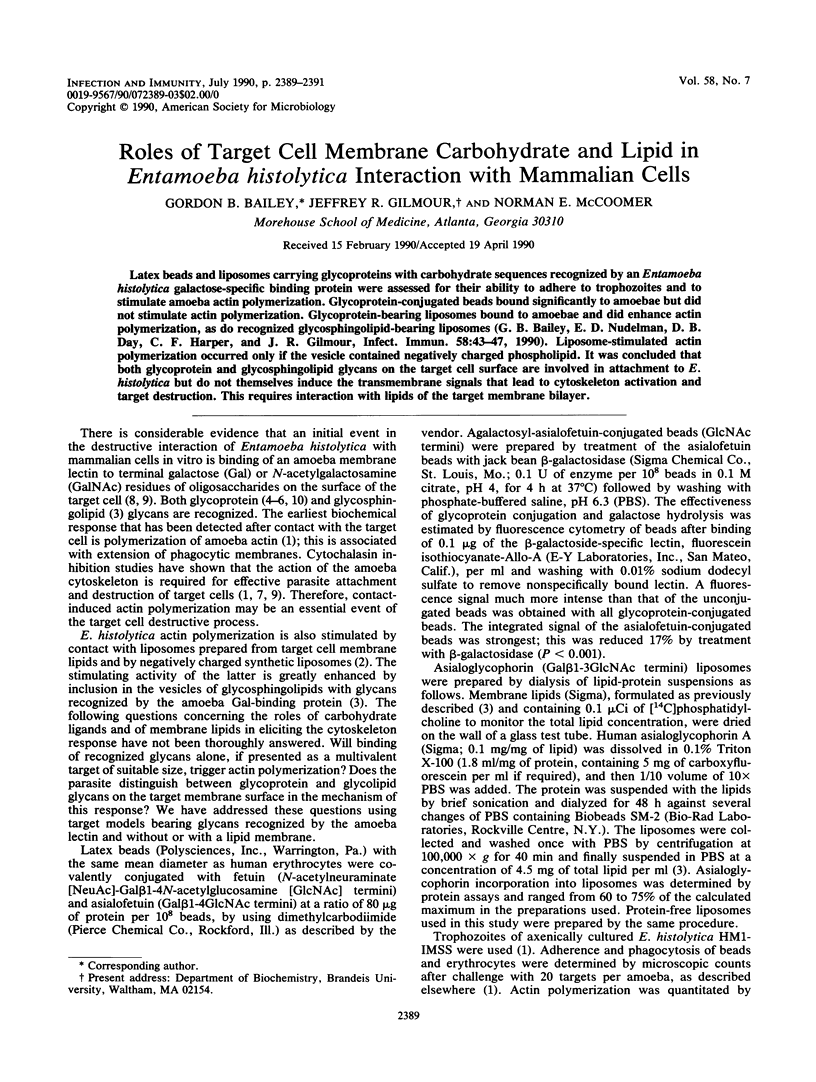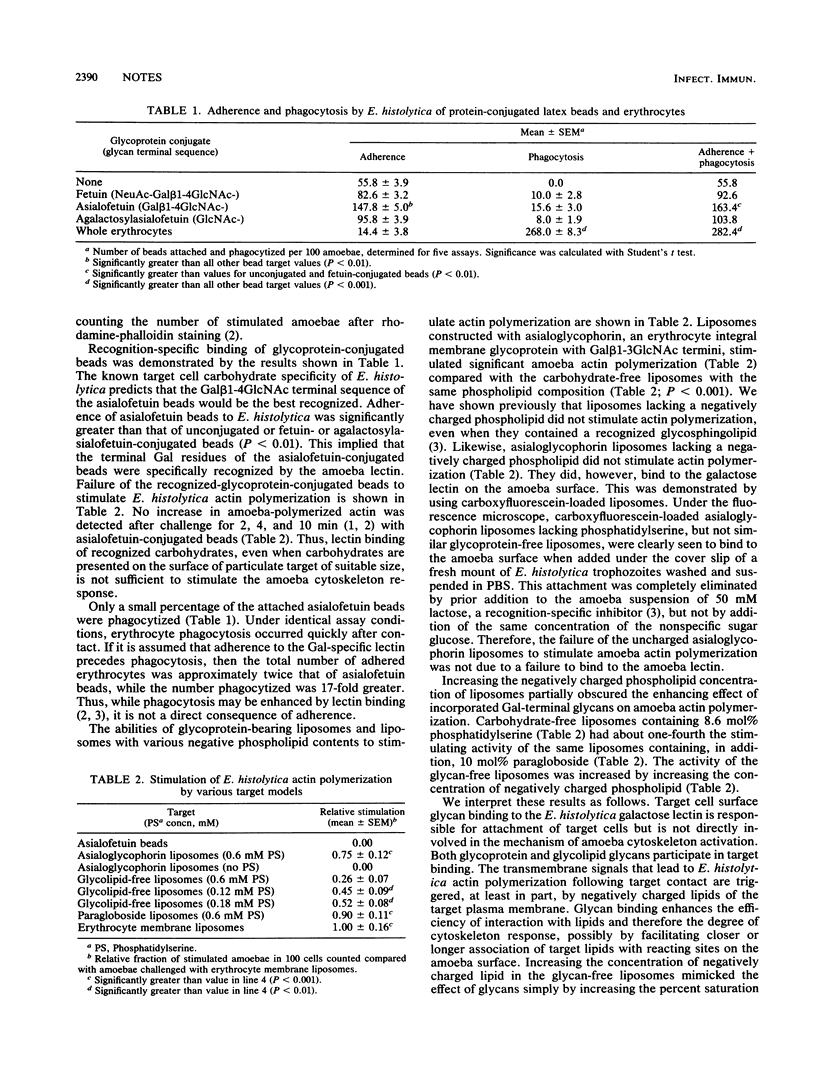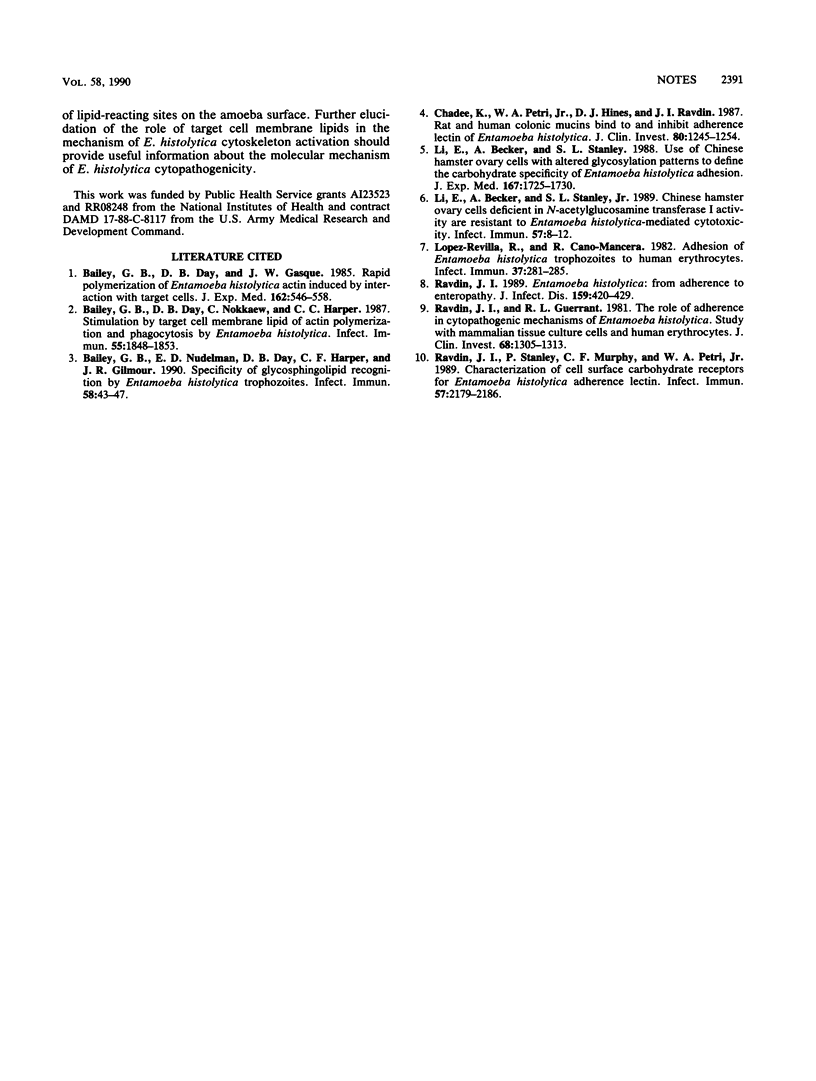Abstract
Latex beads and liposomes carrying glycoproteins with carbohydrate sequences recognized by an Entamoeba histolytica galactose-specific binding protein were assessed for their ability to adhere to trophozoites and to stimulate amoeba actin polymerization. Glycoprotein-conjugated beads bound significantly to amoebae but did not stimulate actin polymerization. Glycoprotein-bearing liposomes bound to amoebae and did enhance actin polymerization, as do recognized glycosphingolipid-bearing liposomes (G. B. Bailey, E. D. Nudelman, D. B. Day, C. F. Harper, and J. R. Gilmour, Infect. Immun. 58:43-47, 1990). Liposome-stimulated actin polymerization occurred only if the vesicle contained negatively charged phospholipid. It was concluded that both glycoprotein and glycosphingolipid glycans on the target cell surface are involved in attachment to E. histolytica but do not themselves induce the transmembrane signals that lead to cytoskeleton activation and target destruction. This requires interaction with lipids of the target membrane bilayer.
Full text
PDF


Selected References
These references are in PubMed. This may not be the complete list of references from this article.
- Bailey G. B., Day D. B., Gasque J. W. Rapid polymerization of Entamoeba histolytica actin induced by interaction with target cells. J Exp Med. 1985 Aug 1;162(2):546–558. doi: 10.1084/jem.162.2.546. [DOI] [PMC free article] [PubMed] [Google Scholar]
- Bailey G. B., Day D. B., Nokkaew C., Harper C. C. Stimulation by target cell membrane lipid of actin polymerization and phagocytosis by Entamoeba histolytica. Infect Immun. 1987 Aug;55(8):1848–1853. doi: 10.1128/iai.55.8.1848-1853.1987. [DOI] [PMC free article] [PubMed] [Google Scholar]
- Bailey G. B., Nudelman E. D., Day D. B., Harper C. F., Gilmour J. R. Specificity of glycosphingolipid recognition by Entamoeba histolytica trophozoites. Infect Immun. 1990 Jan;58(1):43–47. doi: 10.1128/iai.58.1.43-47.1990. [DOI] [PMC free article] [PubMed] [Google Scholar]
- Chadee K., Petri W. A., Jr, Innes D. J., Ravdin J. I. Rat and human colonic mucins bind to and inhibit adherence lectin of Entamoeba histolytica. J Clin Invest. 1987 Nov;80(5):1245–1254. doi: 10.1172/JCI113199. [DOI] [PMC free article] [PubMed] [Google Scholar]
- Li E., Becker A., Stanley S. L., Jr Chinese hamster ovary cells deficient in N-acetylglucosaminyltransferase I activity are resistant to Entamoeba histolytica-mediated cytotoxicity. Infect Immun. 1989 Jan;57(1):8–12. doi: 10.1128/iai.57.1.8-12.1989. [DOI] [PMC free article] [PubMed] [Google Scholar]
- Li E., Becker A., Stanley S. L., Jr Use of Chinese hamster ovary cells with altered glycosylation patterns to define the carbohydrate specificity of Entamoeba histolytica adhesion. J Exp Med. 1988 May 1;167(5):1725–1730. doi: 10.1084/jem.167.5.1725. [DOI] [PMC free article] [PubMed] [Google Scholar]
- López-Revilla R., Cano-Mancera R. Adhesion of Entamoeba histolytica trophozoites to human erythrocytes. Infect Immun. 1982 Jul;37(1):281–285. doi: 10.1128/iai.37.1.281-285.1982. [DOI] [PMC free article] [PubMed] [Google Scholar]
- Ravdin J. I. Entamoeba histolytica: from adherence to enteropathy. J Infect Dis. 1989 Mar;159(3):420–429. doi: 10.1093/infdis/159.3.420. [DOI] [PubMed] [Google Scholar]
- Ravdin J. I., Guerrant R. L. Role of adherence in cytopathogenic mechanisms of Entamoeba histolytica. Study with mammalian tissue culture cells and human erythrocytes. J Clin Invest. 1981 Nov;68(5):1305–1313. doi: 10.1172/JCI110377. [DOI] [PMC free article] [PubMed] [Google Scholar]
- Ravdin J. I., Stanley P., Murphy C. F., Petri W. A., Jr Characterization of cell surface carbohydrate receptors for Entamoeba histolytica adherence lectin. Infect Immun. 1989 Jul;57(7):2179–2186. doi: 10.1128/iai.57.7.2179-2186.1989. [DOI] [PMC free article] [PubMed] [Google Scholar]


